- Home
- John Barth
The Friday Book Page 12
The Friday Book Read online
Page 12
One advantage of electronic tape as a narrative medium is that it has some of the virtues of the oral tradition, where literature started—I mean the immediacy of the human voice and the intimacy of storytelling, which can only be echoed on the printed page—and some of the virtues of print, such as referability and repeatability. You can replay a tough or delightful passage on tape, or pause to let it sink in, as you can when you’re reading but can’t when you’re watching a film or a stage play.
These pieces share some preoccupations with my novels. They’re meant to be serious enough to be taken seriously, but they’re not long-faced. They’re pessimistic, but I hope they’re entertaining. In all of them, for better or worse, the process of narration becomes the content of the narrative, to some degree and in various ways; or the form or medium has metaphorical value and dramatical relevance. The medium really is part of the message. Second, most of them exploit, one way or another, ambiguities of language and narrative viewpoint—especially narrative viewpoint—to make their particular sense. Neither of these is a new idea. Third, one objective of most of these stories—the most important to me—is to try whether different kinds of artistical felt ultimacies and cul-de-sacs can be employed against themselves to do valid new work: whether disabling contradictions, for example, can be escalated or exacerbated into enabling paradoxes. This objective represents to me in its little way a general task of civilized people nowadays.
Finally, if the pieces are successful by my personal standards, they have to be more than just tricky. If I believed my writing were no more than the formal fun-and-games that Time magazine makes it out to be, I’d take up some other line of work. The subject of literature, says Aristotle, is “human life, its happiness and its misery.” I agree with Aristotle.
That’s why we object to the word experimental. It suggests cold exercises in technique, and technique in art, we all know, has the same importance as technique in love: Heartless skill has its appeal; so does heartfelt ineptitude; but what we want is passionate virtuosity. If these pieces aren’t also moving, then the experiment is unsuccessful, and their author is lost in the funhouse indeed.
The Role of the Prosaic in Fiction
THE BEST symposium was Plato’s; all symposia since have been anticlimactic. My daimon, in his absolute way, says “Say no to all symposia,” but I don’t always listen.
I cannot imagine why Canisius College, a small Catholic school downtown from SUNY/Buffalo, sponsored a symposium on so curious a topic as “The Role of the Prosaic in Fiction”: a far cry indeed from the topic of Plato’s Symposium. I cannot imagine either why I agreed to sit on it: The honorarium was modest, and I had no a priori interest in the subject. Perhaps it was out of respect for my fellow symposiasts: the late crusted reactionary George P. Elliott, some of whose fiction I admired but whose literary opinions—an anticipation of the later John Gardner’s—I found disagreeable; and my friend and colleague the erudite, unpredictable, iconoclastic, large-spirited troublemaker Leslie Fiedler, from whose outrageous statements I have seldom failed to learn. Or perhaps it was that in April 1970 I was as aforementioned between lives, living alone for the moment in a cottage on Lake Chautauqua, writing a triad of novellas called Chimera, commuting up the Thruway to my classes, and more disposed than normally to the prospect of an extra evening in town, even for a symposium that would not likely be a love-feast.
I have no recollection of what Elliott and Fiedler said about the role of the prosaic in fiction—what a topic!—or why they were symposing on a subject that cannot in itself have much interested them, either. I know that my own opinions were invented ad hoc, but that—as sometimes happens—having set them forth, I discovered that I believed them. Reviewing them now, I discover that I still do.
The three meanings of prosaic are (1) of or like prose; not poetic; (2) matter-of-fact, straightforward; and (3) lacking in imagination, dull. Discarding most of the third sense—since unimaginativeness has no legitimate role in literature—I think that these definitions correspond to three functions of the prosaic in fiction, having to do with three aspects of the art itself: its matter, its manner, and its medium.
1. With regard to the first aspect (and the last definition), I take “the prosaic” to mean humble facts, specification, homely particulars. Their justification in fiction is mainly self-evident: Objects in literature aren’t really objects, but only the names of objects, and readers and writers share the human pleasure in naming things. We start like Adam, saying “This is a tree; this is a helpmeet; this is a pomegranate”; and we go on, in life and in literature, through Homer’s catalogue of ships, Virgil’s Carthaginian frescoes, the passage on horse’s harness in Don Quixote which I remember having to look up every noun of in my Spanish-English dictionary only to find that I didn’t know what the English equivalents meant either, Henry James’s celebrated “solidity of specification,” Nabokov’s urging his Cornell students to “caress the details” (Q: What kind of meat was in the butchers’ barrels in those flaring streets where-along the young narrator of James Joyce’s story “Araby” carries the secret burden of his love? A: Pigs’ cheeks), and John Updike’s credo that “Details are the giant’s fingers.” At forty and sixty and eighty, God willing, the old Adam in us is still pleased to remark: “This is a plinth; this is a paraboloid; this is a Pouilly-Fuissé 1966.”
Paul Valéry declared that the reason why he could never write a novel is that he couldn’t bring himself to set down such prosaic particulars as “The Marquis went out at five”; Claude Mauriac, a French New Novelist, uses that line as the title of one of his novels. In realistic fiction, from Petronius through Proust to Pinget, such prosaic detail is the very substance. In satiric fantasy it is commonly the ground and foil for its contrary, Sancho Panza to Don Quixote: Rabelais’s giant pisses real piss in unreal quantity; Gulliver in Lilliput besmirches his drawers; real brand-names and place names make Donald Barthelme’s world at once less and more strange. In “irreal” fictions generally, convincing prosaic detail mediates between our waking world and the dreamed ones of, say, Kafka or John Hawkes—as it does routinely in science fiction, pornographic fantasy, and various kinds of allegory. Finally, in the “minimal,” “algebraical,” or otherwise stripped-down fictions of Beckett, Borges, Robbe-Grillet, or Calvino, prosaic detail, when we come upon it, is the source of the fire for which the algebra exists. Such fictions remind us of Gertrude Stein’s remark about the Spanish landscape: It has few things in it, and so each stands out with a peculiar substantiveness. Our relief, when we come upon the homely chair in Ted Hughes’s story “Snow,” is as great as the narrator’s; that chair is the only object in sight besides himself, and from it he infers a world.
2. Second, we can take prosaic to mean a “straightforward” or “naïve” as opposed to an oblique or self-reflexive manner of storytelling. Not much modern fiction is prosaic in this sense. Innocent story—the “naïve anecdote,” Robbe-Grillet calls it—has pretty much gone the way of innocently representational painting and sculpture. It survives in non-“straightforward” forms such as parody and some fantasy, in nonfiction such as Capote’s, Mailer’s, and Tom Wolfe’s, and in programmatically traditional writers like Styron, Updike, and Bellow, where even so it tends to a freight of symbolism, even allegory, or, at its most heavyfooted (as in Updike’s otherwise admirable The Centaur), mythography-in-reverse.
More usually, what prosaic “straightforwardness” there is in contemporary fiction is either a sly disguise, as in Kafka or Nabokov, a momentary relief, as in Beckett’s occasional terse anecdotes, or, as with the cases of homely detail I spoke of before, a kind of simplicity at which one arrives by way of irony and complexity. Fools, children, sentimentalists, pet dogs, and false-naïfs may wear their hearts on their sleeves; the rest of us can’t be got to so easily. Artistic good faith is one thing, aesthetic simplism another.
To sum up this point: The role of prosaic straightforwardness in modern fiction is characteristically dupli
citous.
3. The third sense of prosaic and the first of its definitions—prose versus verse as a narrative medium—seems to me the most interesting aspect of our subject. Printed prose is historically a most peculiar, almost an aberrant, way of telling stories, and by far the most inherently anesthetic: It is the only medium of art I can think of which appeals directly to none of our five senses. The oral and folk tradition in narrative made use of verse or of live-voice dynamics, embellished by gesture and expression—a kind of rudimentary theater—as do the best raconteurs of all times and places. Commonly there was musical accompaniment as well: a one-man theater-of-mixed-means. Early written fiction—the Sanskrit tale-cycles, the Thousand and One Nights, and so forth—reflects this; while it typically and sometimes elaborately acknowledges its condition as writing (see for example the wonderful Kathapitha, or “Story of the Story,” which opens Somadeva’s enormous Katha Sarit Sagara, or “Ocean of Streams of Story”), such fiction is usually about people telling one another stories, interspersed with poems, songs, and dances.
Verse especially, as a narrative medium, has served purposes more subtle than merely heightening the sensory appeal of language. Jaromir Hladik, the playwright in Borges’s story “The Secret Miracle,” chooses metrical verse as the essential medium for his drama because “it makes it impossible for the spectators to lose sight of irreality, one of art’s requisites”—in other words, it prevents our mucking up the useful distinction between art and life. In the eighteenth and particularly the nineteenth century, as verse-drama and narrative poetry were more and more supplanted by the novel and by realistic prose drama, one observes that grand opera and classical ballet—those least prosaic, most irreal of narrative media—flowered, almost as if in compensation, as the inheritors of the older narrative tradition. It passes in our century to the cinema, whose camera effects and musical soundtrack can redeem any scene from being prosaic in the pejorative sense and heighten, if not always save, the prose of the spoken dialogue—always adding, even in the most realistic films, Borges’s “essential element of irreality.”
But novels and stories in printed verse—Philip Toynbee’s, for example—simply seem seldom to work, except in rare cases where the medium is employed with some ironical covering of tracks, as in Nabokov’s Pale Fire. In most post-realistic prose fiction, the essential element in the transmutation of the prosaic into art is provided either by irreality in the conceit, as in Borges himself (and Kafka, Beckett, late Joyce, middle Malamud, Ionesco, Calvino, Landolfi, Gombrowicz, Grass, Brautigan, Barthelme, Vonnegut, and who have you), or by a radical unprosaicizing of the prose, as in late Joyce, Faulkner, Hawkes, some Nabokov, etc., or by radical manipulations of narrative viewpoint, dramatic form, or format, as in most of the aforementioned plus the French New Novelists, William H. Gass, Robert Coover, and The Something Else Press writers—or by combinations of all of these.
In short, the role of the prosaic in prose fiction comes first to something akin to the role of “flat” lines in poetry as described by Yeats when he remarked that a mountain is mountainous because it has valley on either side; and, second, to something akin to the role of ordinary reality in dreams: to supply the bones to be transformed by the writer’s imagination into something rich and strange. To the extent that this transformation doesn’t occur, one has prosaic fiction in the unhappy sense: dull and tedious writing.
The Ocean of Story
The eleventh-century Sanskrit Ocean of Story got mentioned in that foregoing symposium statement because, between writing the Chimera novellas, I was reading through that huge, peculiar work and registering my reactions to it in a demi-essay. When Henry Sams, chairman of the immense Department of English at Penn State during most of my stay there, retired from that office, his colleagues published the somewhat presumptuously titled Directions in Literary Criticism: Essays in Honor of Henry A. Sams.* My grateful contribution to that Festschrift follows: no Direction in Literary Criticism, merely a bemusement I knew Henry would share.
The road to India is a long road, but it is the only way to India. One can’t expect to get through The Thousand and One Nights in one night. When I worry that one of my stories is growing overlong, I tell myself the story of a really long story: Katha Sarit Sagara, or The Ocean of Streams of Story, more or less by the eleventh-century Indian poet Somadeva.
Its title haunted me for a dozen years (as did Calderón’s La Vida Es Sueño) before I ever read beyond it. As an undergraduate book-filer in the classics and Oriental Seminary stacks of Johns Hopkins’s Gilman Hall Library, I would push daily past the ten huge sea-green volumes of Penzer’s edition (privately printed in London in 1924 and still the only English-language edition one sees) of Tawney’s nineteenth-century prose translation of Somadeva’s Sanskrit redaction of King Satavahana’s third-century publication of his minister Gunadhya’s Paisachi versification of the demigod Kanabhuti’s retelling of the demigod Pushpadanta’s version of the Great Tale first told by the god Siva to his consort Parvati. Inevitably, semester after semester, that golden title, The Ocean of Story, took my eye and fancy. But waiting on the book cart to be reshelved (and read, surreptitiously, on company time) were more-navigated ways of narrative: The Thousand and One Nights, The Panchatantra, the Pent-, Hept-, and Decamerons. One never found allusions to The Ocean of Story in other literature or heard it mentioned by one’s professors and better-read friends; indeed, one never saw Somadeva off the shelf—where I filed beside his mare incognitum my resolve one day to embark upon its endless reaches. For the present there were those more famous works to be read, more of them than one ever would find time for, and from the springs of literature issued unceasingly a torrent of new writing as well, to be breasted if possible. Presently one’s own outpourings were added to the general flood. There was no time.
Until one arrived, enough years later, at the free port of understanding that, like Magellan, one will never accomplish the whole voyage. One will not likely ever get around now to Camöens’s Lusiad, I came to realize, or the rest of Hardy, or the end of Eugene Onegin, or the beginning of Jerusalem Delivered; and even a second lifetime would not suffice to get said the whole of what oneself had aspired to say. This recognition, when not traumatic, grants an extravagant liberty: The voyage being incompletable, one may take side trips of any length in any number, at one’s pleasure! In connection, therefore, with a casual research of some years’ standing through the whole corpus of frame-tale literature, I lately made at last my leisure-cruise from end to end of The Ocean of Story.
Was it that too long deferral of the journey staled its charm? Or that no merely actual fiction could realize the long work of my imagination upon that title? In any case, I must report that:
1. In the main, alas, the tales rehearsed by Somadeva (whose noble ambition was to tell them all) are less memorable than Scheherazade’s, say, or Boccaccio’s or Chaucer’s—or less memorably recounted, in the several instances where the plots are analogous. In keeping with Somadeva’s (and his precursors’) conceit of an ultimate narrative ocean into which all the streams of fancy flow at last, entire Gangeses of pre-existing fiction are tapped and incorporated, such as the Panchatantra and the Vetalapanchavimsati, or 25 Tales by a Vampire. It is principally through the numerous redactions, recensions, and meanders of these tributaries—Siddhi-Kur, The Seven Sages, Kalilah and Dimnah, Syntipas the Philosopher, The Fables of Bidpai, Sindibad’s Parables —and later reworkings of these reworkings—Johannes de Alta Suva’s Dolopathos, John of Capua’s Directorium Vitae Humanae, Firenzuola’s Discorsi degli Animali, and Doni’s Novelle, for example—that waters from The Ocean of Story finally enter the mainstream of Western literature, and in most instances they gain flavor from their circuitous journey. To put the figure more accurately: Several of the springs that fed The Ocean of Story trickled westward also and separately, with the consequence that Somadeva’s vast poem strikes one less as a source of Western narrative motifs than as a kind of anthology or compendium of such
sources. Hence, in part, its persisting obscurity, except among Orientalists, despite its being, in Penzer’s odd phrase, “for its size, the earliest collection of stories extant in the world.”
2. The frame-structure, too, is less arresting or fecund than that of The Thousand and One Nights, The Decameron, or, for that matter, the anonymous seventeenth-century English delight entitled Westward for Smelts. Nothing in the circumstantial history of Prince Naravahanadatta and the Vidyaharas captures the imagination as does the image of Scheherazade yarning through the night to save her neck, or Boccaccio’s twilit company beguiling themselves with fiction in despite of plagued fact. On the other hand, Somadeva’s structure is considerably more complex—the most complex, I think, among the nearly 200 specimens of frame-tale literature I’ve thus far noted. Not only is the narrative at several points involved to the fourth degree (tales within tales within tales within tales), but at any degree, including the first or outermost, the frame may be serial and achronological—as if, for example, the pilgrimage to Canterbury were only one among several frame-conceits in Chaucer’s poem, and began outside Rochester at that, the departure from London being filled in only later; as if, moreover, his Troilus and Criseyde were one of several tales told by Patient Grisilde, whose tale in turn were one of several told by Chanticleer, whose tale were one of several told by the Nun’s Priest, et cetera. The intrication is enormous (stout Penzer uses a schematic outline in his table of contents: The story of King Brahmadatta, for instance, is Tale 1BB in the midst of Tale 1B in the Cont[inuation] of Tale 1 in the Cont[inuation] of the M[ain] I[ntroduction] in Chapter III of Book I); but like the complexity of termite tunnels or lymphatic cancer, it is more dismaying than delightful from the human point of view.

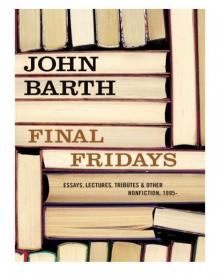 Final Fridays
Final Fridays Where Three Roads Meet: Novellas
Where Three Roads Meet: Novellas Every Third Thought: A Novel in Five Seasons
Every Third Thought: A Novel in Five Seasons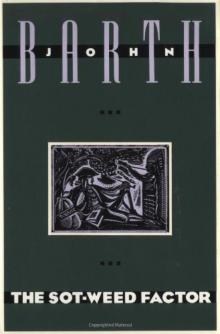 The Sot-Weed Factor
The Sot-Weed Factor The Friday Book
The Friday Book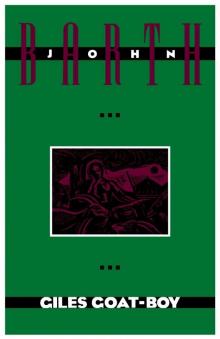 Giles Goat Boy
Giles Goat Boy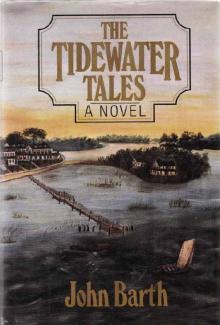 The Tidewater Tales
The Tidewater Tales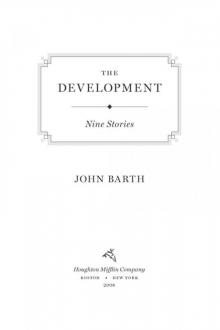 The Development
The Development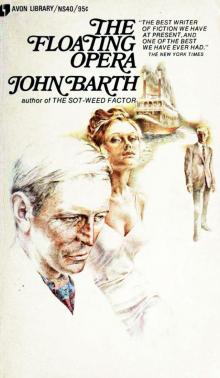 The Floating Opera
The Floating Opera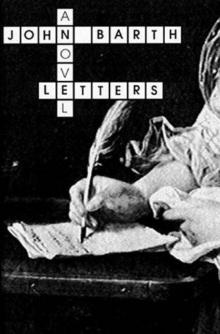 Letters
Letters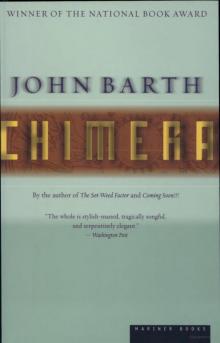 Chimera
Chimera Where Three Roads Meet
Where Three Roads Meet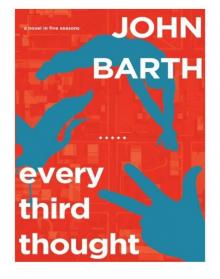 Every Third Thought
Every Third Thought